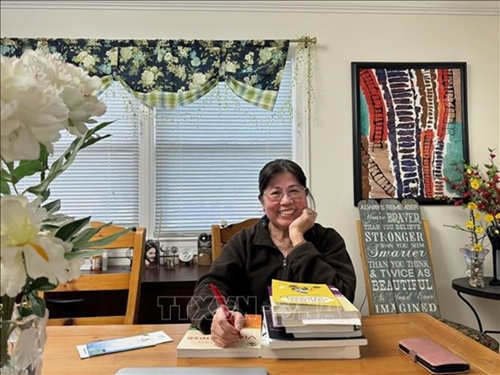Preliminary statistics show that there are nearly 200 establishments and centers teaching the language in the U.S., mainly in the states housing large Vietnamese communities like California, Texas, and Washington, but most of them are of small scale and still depend on voluntary teachers.
    |
 |
|
Ngo Kim Viet at her home in the U.S. |
Meanwhile, the U.S.’s centers of foreign languages have just opened Vietnamese language courses for diplomats and nationals preparing to work in the Southeast Asian country.
Viet told the Vietnam News Agency that her decision to teach the language came from her love for the homeland, adding she doesn’t want the Vietnamese born and growing up in the U.S. to be unable to speak the mother tongue due to the shortage of schools, teachers, or an environment for them to practice.
Given this, she decided to voluntarily help children of Vietnamese families to learn the language and open classes at churches.
In 2014, her nephews returned to Vietnam on business trips. Despite their Vietnamese origin, they still had to hire interpreters during those trips. Therefore, Viet decided to teach them via Zoom so that they can communicate in Vietnamese in future returns.
The woman has also been teaching at language centers of the U.S. whenever she has spare time. She has bought language teaching books along with those about the culture and history of Vietnam, and also referred to images and videos in the internet to compile her own lesson plans.
Though the part-time job brings her almost no income, Viet still wishes to maintain and popularize the beauty of the Vietnamese language, prompted by her love for the mother tongue,
Viet said she was happy that the Vietnamese Embassy in the U.S. recently invited her to attend a Vietnamese language class held by the Vietnamese Ministry of Foreign Affairs for expatriates. Due to the time zone difference, the class started at 5 a.m. in the East Coast of the U.S., but she didn’t miss any lessons because she considered this a precious chance for her to improve specialized knowledge and teaching skills.
Sharing some interesting stories about her students, she said the Vietnamese language has helped one of her nephews to confidently return to the homeland without an interpreter, another to assist his company in the U.S. to sign a contract with a Vietnamese partner, a U.S. priest to talk to his Vietnamese followers and understand more about the country’s culture, and many Vietnamese-origin people in the U.S. to support those unable to speak English.
With their patriotism, Viet and those engaging in the teaching of the Vietnamese language in the U.S. are inspiring the interest in the mother tongue among young people there, while helping the youth be further aware of the necessity and value of the language maintenance and learn more about the homeland’s culture.
Source: VNA